Confession time: I dread hearing my books read aloud. OK, the odd sentence or two, maybe even a whole paragraph, can sound pretty cool but sooner or later comes the repeated word, the clumsy phrase, the unplanned alliteration that will cause even the most skilled reader to stumble. The reading eye, given as it is to skimming, is remarkably forgiving, skating over the ill-formed prose with barely a hitch. But the ear? Oh my, the ear misses nothing.
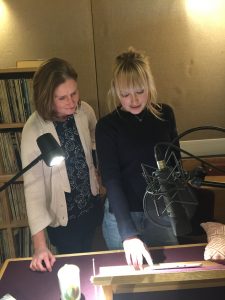
It is for precisely this reason that I read my books aloud before I submit them to the editing process. It’s a mammoth task, taking the better part of a week, but it improves the text immeasurably. (For what it’s worth, this is always my default piece of writing advice.) But still the errors slip through. I have to force myself to listen to my audio books. It’s a necessary penance, though, because I know it will push me to do better next time.
And yet, in spite of all this, I find myself looking forward with almost indecent haste to the audio version of The Craftsman. Yesterday, with my editor, Sam Eades, I visited the studio in Clerkenwell where the lovely and talented Nathalie Buscombe was bringing both The Craftsman and Alive to life. She was amazing, with a rich, expressive voice, as you’ll hear from this sneaky piece I was able to steal. Enjoy.
Alive (a free short story) will be available on audio from March 1 and The Craftsman, published on 5 April, can be pre-ordered now.
Follow Nathalie on twitter @NattieBuscombe
I’ve had some very nice foreign rights news this summer, with deals for A Dark and Twisted Tide in the Czech Republic, Dead Woman Walking and Awakening in Poland, Daisy In Chains in Croatia, Dead Woman Walking in Norway, The Craftsman in Germa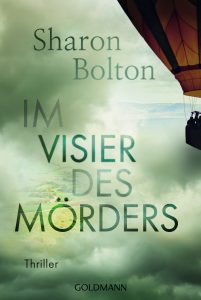 ny and Sweden and a brand new Italian publisher, Newton Compton, who will be publishing Dead Woman Walking sometime next year. My thanks, as always, to Rosie and Jessica Buckman of The Buckman Agency for all their hard work.
ny and Sweden and a brand new Italian publisher, Newton Compton, who will be publishing Dead Woman Walking sometime next year. My thanks, as always, to Rosie and Jessica Buckman of The Buckman Agency for all their hard work.
Seen here is the gorgeous German cover for Dead Woman Walking which will be published as Im Visier Des Morders or In Sight of Murder.
“Lacey Flint, a woman with more secrets than Victoria’s flagship lingerie store, walked the long, high, carpeted corridor and paused at the door of Apartment 5b. In the last couple of years she’d swum through the sewers of London, tackled terrorists on the Thames, hunted down a Jack the Ripper copycat and slit her own wrists. Today would be something else.”
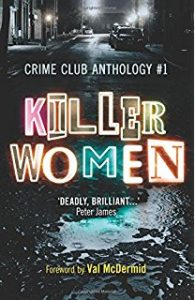
Any Lacey Flint fans out there? The Corpse In the Copse, a Lacey Flint tale, will feature in the second Crime Club anthology of short stories by my fellow Killer Women. Other contributing authors include Sarah Hilary, Elly Griffiths, Julia Crouch, Erin Kelly, Laura Wilson and Jane Casey.
Mark Billingham called it, ‘…a killer collection of dark and devious tales.’ Linwood Barclay agreed, saying, ‘a lot of women have terrified me over the years, but none quite like these.’ SJ Watson said,’This mix of playfully twisted, macabre tales showcases the Killer Women at the top of their game. I loved it.’
Blade sharp and pared to the bone, these original stories by bestselling, award winning female crime writers will lure you to the dark side
Order here.
I’m delighted to announce that I’ve joined Killer Women, the London-based collective of female thriller writers that, in a little over a year, has become a major force in the UK crime writing scene. I’ve already attended my first Prosecco-fuelled ‘salon’, in the dark basement of a Clerkenwell pub, and couldn’t be more exited about the plans these dangersome ladies have in place for the coming months.
Other new recruits to the club of the deadly are my good friends Elly Griffiths, Julia Crouch and Amanda Jennings, and taking the total from fifteen to twenty are Rachel Abbott and Emma Kavanagh, both of whom I very much look forward to meeting soon.
Including award winning and best selling authors, Sarah Hilary, Paula Hawkins, Jane Casey, MJ McGrath and Erin Kelly, Killer Women was formed in 2015 to enable its members to share knowledge, provide mutual support and promote the work of British women crime writers.
Killer Women quickly became an established brand in UK crime-writing, one with which numerous publishers have wanted to be associated. The inaugural festival in Shoreditch last October was a sell-out success, attracting major sponsorship and TV attention, whilst the Crime Club Anthology, a collection of fifteen short stories, has been shortlisted for a prestigious Audie Award. During the year, Killer Women give talks and interviews, attend festivals and support bookshops and libraries.
Anyone interested in their work can sign up to The Killer Women Club to get exclusive monthly updates. Here. More information on the collective can be found on their website. Here.
The Killer Women are:
Alison Joseph, Amanda Jennings, Colette McBeth, DE Meredith, Elly Griffiths, Emma Kavanagh, Erin Kelly, Helen Smith, Jane Casey, Julia Crouch, Kate Medina, Kate Rhodes, Laura Wilson, Louise Voss, Louise Millar, Melanie McGrath, Paula Hawkins, Rachel Abbott, Sharon Bolton, Sarah Hilary and Tammy Cohen.
Towards the end of last year I made one of the toughest decisions of my life when I chose to leave a relationship of ten years standing. For a decade I’d been nurtured and cared for, given the security and confidence I needed, pushed to achieve and caught when I stumbled. When times were good, I’d been cheered on and praised, I’d been comforted when things didn’t go so well. It was a relationship based on respect, gratitude, friendship and deep affection (for my part at least) and for years I hoped it would never end.
But two things happened. First, I fell in love. Then I learned that I’d changed, and that what had served me so well for ten years was no longer what I needed going forward.
Lest Mr B is breaking out the Babycham, I should probably clarify. I decided to move publishers. I signed a new contract just before Christmas and will be moving from Transworld to Orion for my next three books.
Because I had indeed fallen in love, in the Autumn of last year, with the passion, intelligence and energy of the Orion team. New imprint, Trapeze, led by Anna Valentine and with the remarkable Sam Eades on board, seemed fresh and vibrant, brimming over with innovative and intriguing ideas. Ultimately, their belief in what we could achieve together proved irresistible.
And I’d changed too. I wanted to write a different sort of book; a book that has always been bubbling away inside me; and that was telling me, with increasing urgency, that its time had come around.
“Witches and Whores”
On an early spring day in 1612, Richard Baldwin, a mill owner in the Pendle Forest of Lancashire chased two local women off his land, calling them ‘witches and whores,’ threatening to ‘burn the one and hang the other.’ Their crime had been to politely request money that was owed to them. Baldwin’s response set in motion events that led to the imprisonment, trial and execution of nine women on the charge of murder by witchcraft: the infamous Pendle Witch Trials.
Legend has it that female children born in the shadow of Pendle Hill are baptised twice. First, in church, to be welcomed into the family of Christ. And then again, in a dark pool at the foot of the hill, where they’re pledged to the service of another master entirely.
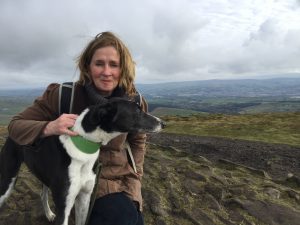
As far as I know, I was only baptized once, but I am a woman of Pendle. The women who were hanged in 1612 could have been my great, great aunts or my ancestral grandmothers. And from my earliest days I’ve known that, had I been born in such a time of misogyny and superstition, I might well have been marked out a witch.
Because I have always been different. The one who stood out. The slightly weird girl at the back of the class, who didn’t fly with the wind, or follow the beaten path. So, I’ve always been intrigued by what makes some women into witches. Is it something in us? Or does the fault really lie with all of you?
The north of England, my homeland, is a dark place. It is the place where, for hundreds of years, dissidents have fled and outlaws have thrived. Shortly before I was born, Ian Brady and Myra Hindley preyed upon children of the north. My teenage wings were clipped by the reign of the Yorkshire Ripper. Mary Ann Cotton, Harold Shipman, Peter Dinsdale, Donald Neilson, were all killers of the north. I’m often asked why I write the sort of books I do. Maybe this is why.
But, I’ve always wanted to write a book about witches. Specifically, how women become witches. Do they make that choice themselves, or is it made for them? I used to think the latter, that it is societies that create witches. Now, after several years of research, I’m not so sure. I no longer dismiss the idea of witchcraft.
The Craftsman is the story of women, and witches. Of the children we love and must protect. And of the men who fear us. It will be published in spring 2018 and I have no doubt I will have much to say about it between now and then.
In the meantime, no relationship ends without pain, and it is hard to say goodbye to my friends and colleagues at Transworld. I wish them well. I am sure they will continue to be the phenomenally successful and greatly admired publishing house that I’ve been privileged to be a part of for ten years. They will always have my gratitude and my love.
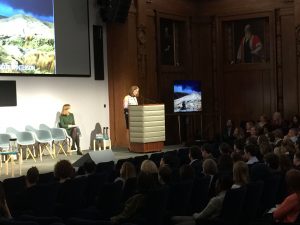
Sam Eades, Editorial Director at Trapeze, has acquired three novels from Sunday Times bestselling author Sharon Bolton. The deal was struck by Anne-Marie Doulton at the Ampersand Agency, for World English rights including audio. Sharon Bolton has sold over one million copies worldwide, winning the Mary Higgins Clark Award for her second novel Awakening and the CWA’s Dagger in the Library Award for a body of work.
The first novel The Craftsman will be a superlead title for Trapeze in Spring 2018.

Beginning a trilogy of ambitious, brooding thrillers, The Craftsman draws upon Sharon’s own background of growing up in the north of England, in the shadow of the Pendle Witch Trials, the Moors Murderers and the Yorkshire Ripper.
Switching between 1969 and 1999, The Craftsman is the story of a community shattered by a merciless predator, and of a young police constable, out of her depth in a climate of misogyny and superstition, battling to solve a case that could make her career. Or change her forever.
Sam Eades, Editorial Director at Orion said: ‘Sharon Bolton is a writer like no other; a writer who instinctively knows our greatest fears and explores the darkest corners of the reader’s mind. She is also one of the hardest working authors in the industry. I have been a huge admirer of hers for years, and know the team here has the vision, passion and experience to take her career to even greater heights. With The Craftsman Sharon has produced her best work yet, the thriller everyone will be talking about in 2018. She will be a jewel in the Trapeze list, and we are very lucky to be publishing her.’
Sharon Bolton, author said: ‘From our very first meeting, I was hugely impressed by the energy, enthusiasm and professionalism of the Trapeze team. I’m honoured by their confidence in me, and very much looking forward to working with them on The Craftsman.’
Anne-Marie Doulton, agent said: ‘Sam Eades’ boundless enthusiasm for and belief in Sharon’s writing together with Orion’s forensic approach to marketing, promotion and sales proved a winning combination. Sharon has spent 10 happy years with Transworld, and the decision to move on was far from easy, but in the end we were both persuaded that the invigorating environment of new imprint Trapeze offers exactly those opportunities and challenges Sharon is keen to embrace. From what I’ve seen so far of The Craftsman, readers have something exceptional in store for them.’
David Shelley, CEO of Orion said: ‘I am so thrilled that we’re going to be working with Sharon Bolton. She is one of my favourite crime writers and I can’t wait to see what she writes next. And I have every confidence that Sam Eades and her very talented, focused team will help Sharon win even more fans.’
Katie Espiner, MD of Orion said: ‘Sharon Bolton is simply one of the finest crime writers working today and I could not be more thrilled that she’s joining Orion. Sam and the team have ambitious plans in place for Sharon, and her new book is absolutely stunning – clever, claustrophobic and nerve-jangling. She’s an incredible talent and it’s a privilege to be working with her.’
Sarah Adams, Fiction Publisher at Transworld said: ‘I could not be more proud of the Transworld team for all they have done to grow Sharon’s readership over the past decade. They have published her with passion, energy and relentless determination, as her brilliant books deserve. Our time has now come to part ways and we all wish Sharon and Orion every possible success in the future.’
Sharon (formerly S J) Bolton grew up in Lancashire and, with a BA in Drama from Loughborough University, spent the early part of her career in arts and entertainment administration. In 1991, she went back into full time education to study for an MBA at Warwick University, where she met her husband Andrew. She worked in the City of London for a number of years before a chance encounter taught her that she could write fiction. In 2001, she left the corporate world to become a mother and a writer.
Her first novel, Sacrifice, was voted Best New Read by Amazon UK, whilst her second, Awakening, won the 2010 Mary Higgins Clark Award (part of the prestigious Edgars) in the US. In 2014, Lost, (UK title, Like This, For Ever) was named RT Magazine’s Best Contemporary Thriller in the US, and in France Now You See Me won the Plume de Bronze. That same year, Sharon was awarded the CWA Dagger in the Library, for her entire body of work.
She has been shortlisted for the CWA Gold Dagger, the Theakston’s Prize for Best Thriller, the International Thriller Writers’ Best First Novel award, the Prix Du Polar in France and the Martin Beck award in Sweden.
With ten books to her name, Sharon is a Sunday Times bestselling author and has been described by a reviewer for that newspaper as being ‘unable to write a sentence not suffused with menace.’
Sharon lives with her family in the Chiltern Hills, not far from Oxford.
THE CRAFTSMAN will be published in Spring 2018 in audio, ebook and hardback.
I take my hat off to movie-makers. Earlier this week, a group of seven of us, occasionally swelling to fifteen, spent the entire day in the Chiltern Hills shooting footage for the video trailer of my new book, Dead Woman Walking. By the end of it, we all felt like dead women (and men) walking. It was completely exhausting. And, the day on location came on top of hours of planning, location scouting, casting, script writing, story boarding and gathering together of costumes and props. Another full day of editing will be needed to get it screen ready.
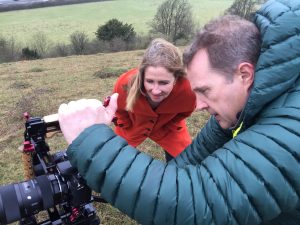
The finished trailer will be approximately 90 seconds long!
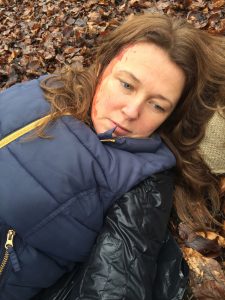
The simplest of actions: a CSI in Tyvec suit brushing aside the hair on a bloodied corpse, had to be shot repeatedly, from every conceivable angle, from a distance, from the middle distance, in tight frame, in close up. And this for a sequence that might last two seconds at most. How three-hour epics like Lord of the Rings get made is beyond me.
But we did it, or at least we’re well on our way. We were blessed to have a very experienced producer and cameraman calling the shots, and we have some chilling and beautifully shot footage in the bag. Fingers crossed it all comes together in the editing suite!
Dead Woman Walking is out on 20 April and can be pre-ordered now. The video trailer should be ready in a couple of weeks.
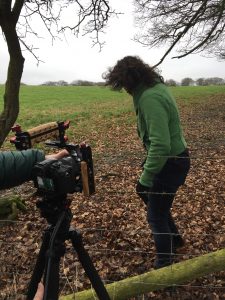
… It’s Who. How often do we say this, bitterly, when others, less talented but with better connections, sweep away the prize that we believe to be rightfully ours? Well, just lately I’ve discovered it’s possible to put a much more positive spin on the old cliche.
A couple of weeks ago, I decided I wanted a video trailer to promote my latest novel, Dead Woman Walking. (20 April in UK, 5 September in US) My tenth book, this is the story of a woman, the only survivor of a disaster, who witnesses something terrible and has to go on the run. Through the wilds of Northumbria, and the ancient city of York, she flees for her life, and we’re never quite sure whom she is most afraid of.
Video trailers, or teasers, were all the rage a few years ago, and I have four fabulous ones that you can see on my YouTube channel here, but then they fell out of favour and publishers invested marketing spend elsewhere.
The wheels turn, things come around, and with the phenomenal rise in the popularity of YouTube, book teaser videos are coming into fashion again. When my fifteen year old son gave my idea the seal of approval I knew I was onto something.
The problem though, how to go it alone? Video trailers are very expensive, miniature movies with sound, lighting, photography, editing. There was no way I could hire a professional video production company and, in any event, all I really needed were a few atmospheric pictures, some eerie music, a still of the book cover. How hard could it be?
‘No,’ said Mr B, in that firm manner of his. ‘I do not have a week to spare learning how to use imovie.’ I looked at my son, a YouTube expert if ever there was one. ‘Homework,’ he said. I was going to have to think outside the box.
So I did. The first step – writing the screenplay – was easy. I’m a writer. I know the story of Dead Woman Walking better than anyone. I’ve even done a short course on adapting my own work. But already my plans were moving on beyond a few artfully shot photographs. I could hear the voice of my tall handsome hero, Ajax (I know!) talking about how important it was to find the missing woman, Jessica. I could see Jessica, fleeing the countryside, hiding in barns, behind trees, cowering in the bathroom for the final climactic scene. I could see how it would work, but could I film all this on an iphone?
And then I remembered John, whose wife is my son’s godmother, and who until very recently was a BBC producer, working on flagship programmes like Panorama. Recently turned freelance, John proved willing to help out a mate, but pointed out my script wasn’t sufficient. I needed a storyboard.
What on earth is a storyboard? A series of pictures, apparently, that will eventually translate into footage. Trouble is, I can’t draw. ‘I can do a storyboard,” said my nephew, the chef. ‘I learned at school.’
I will never be rude about Media Studies A level again, because a few days later, we had our storyboard. In the meantime, I was casting. Nephew Sam will be perfect as Patrick the sinister gypsy. My friend Jill looks a lot like Jessica. Other friends seem surprisingly keen to be dead bodies in the opening scene – the disastrous aftermath of a hot air balloon crash.
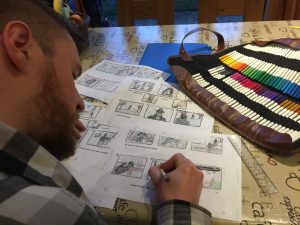
‘A hot air balloon flight? A crash? A chase across the countryside? Isn’t this getting a bit, you know, ambitious,’ said Mr B, in that worried way he has. ‘Yes,’ I agreed. ‘It’s going to be awesome.’
Because I know a man with a balloon. Richard, who helped me write the opening chapter of Dead Woman Walking. We’re waiting for the ground to dry out so that he can take his first flight of the year and I can get arty, moody shots of the balloon inflating, the burner firing, the basket soaring into the sky. (No, I won’t ask him to crash, we can fake that bit!)
It was all going so well. Then we hit a snag. Music. Footage without music falls flat. The right soundtrack is crucial, but paying to use existing music is prohibitively expensive. I knew this already, because my previous trailers had had music specifically composed for them. Did I know any composers?
Yes, I did. My dog-walking friend’s middle son, Will, is a talented musician and, I had a feeling, a budding composer. Might he be interested? He was, and we now have a creepy, menacing piece of music that will be perfect. From a sixteen year old boy!
I was beginning to feel blessed. Mr B and I set out in the pouring rain one Sunday morning to find locations and discovered parts of the Chiltern Hills that, with a soft focus lens, will be virtually indistinguishable from Northumberland where Dead Woman Walking is set.
So, here we are, a brand new video production company with a director, a storyboard, a cast, locations, music, a balloon on standby and dates in the diary to do the shoot. Of course it could all go horribly wrong, and we could end up with something unusable, but I don’t think so. I am almost as excited about what we’re going to do together as I am about the book coming out.
I think we’re going to create 90 seconds of fabulousness. Because, it’s not always what you know. It’s who you know.
And I know some amazing, clever, wonderful people.
Dead Woman Walking is out on 20 April in ebook and hardback. Pre-order here.
(From the archives)
If there’s one enquiry guaranteed to send me into orbit at this time of year it’s: “Are you ready for Christmas?”
The next time I talk to my mother on the phone I know she’s going to ask me exactly that; other parents at school pick-up will start slipping it in too; passing acquaintances will accost me in the street, enquiring cheerfully as to the state of my Yuletide readiness. Round about the 15th of the month it will get shortened to: “Are you ready yet?’
Why do they do it?
Not only is it jaw-clenchingly annoying, it’s meaningless to the point of being moronic (it’s OK, mum doesn’t read my blog) in its assumption that there’s a point to be reached in the next couple of weeks when every preparation has been made and we can sit, in smug and expectant idleness, waiting for Christmas to happen to us.
Seriously now, when can that point possibly be reached? Once we have presents wrapped, cards posted, tree trimmed, menus planned, etc? Or do we have to buy the food, cook the dinner, plate it up and stick it in the freezer ready to be micro-waved back to edibility? At what stage does the effort stop and the Christmas begin?
And running alongside the list of chores are the build-up events, the carol concerts, drinks parties, nativity plays that I think, way back in history, were intended to be enjoyable but have long since become a series of hurdles to leap before we can reward ourselves with Christmas. It’s as though the entire month of December has become a sort of virtual advent calendar with each day bringing along a pre-Christmas trial to be endured. Just a glance at the diary right now is enough to give me the jitters:
Dec 1st – Advent Service
Dec 2nd – School Christmas Fair
Dec 3rd – Wedding (Wedding? Don’t they bloody well know we have Christmas to get ready for?)
In one short, annoying sentence. ‘Are you ready for Christmas?” embodies one of the deepest problem with my life and, I suspect, with quite a few others as well because it implies that the life we are living at the moment is nothing but a series of tiresome but unavoidable chores that we have to work our way through for the promise of the distant reward. Asking people if they are ready for Christmas in the first few days of the month puts the emphasis on moving as quickly as possible to a desired end, at the expense of enjoying the process.
I’ve fallen into exactly the same trap with my latest book. End of December is an important deadline for me, the date by which I aim to have finished the first draft. Agent Anne Marie and Mr B give me their initial thoughts early in January (never complimentary but I’m used to it) and I can spend the following six weeks refining and polishing before it has to go to my publishers at the end of February.
I’ve known for several weeks now that the first draft will not be done by end of December and with that knowledge has come a gradually increasing sense of panic. My priority now is building the word count, getting closer to the desired 110,000 as quickly as I can. It is not where it should be, and that is on making each chapter or scene as impactful as possible. I’m skipping research, glossing over characterisation, leaving out atmosphere and, most importantly of all, I’m not particularly enjoying the process.
This is wrong, because there were many times in the early days of this novel when I genuinely thought it could be my best yet. I was loving what was unfolding before me. I’m not now. Now every hour at my keyboard is a trial to get through.
How did it happen? How did a job I love to bits become a chore?
It got Christmassed, is what happened. In my desperation to get to the finish line, I lost sight of the joy of the race. Which was both stupid and unnecessary. Book six will not hit the bookshops until Spring 2013. I have plenty of time. And no one will enjoy reading a book that I haven’t enjoyed writing. So, tomorrow I will turn off my word count tool and concentrate on writing a scene in which my young hero, Barney, talks to two adults whom he likes and trusts, both of whom could be cold-blooded killers. I have to make it sad, and touching and bone-chillingly scary.
As for Christmas, well the advent service made me cry sweet, sentimental tears, as it always does and the Christmas Fair, as usual, is the nicest event the PTA runs all year. The wedding was delightful: cold, beautiful and glittery. We sat on a table of people who have known each other for decades and who greeted us, perfect strangers, as old friends. Yesterday I wrapped presents, which I always enjoy because I’m good at it and tomorrow I’m going out for a Christmas meal with a dozen other mums from the village. On Wednesday Mr B is going to watch Handel’s Messiah at St Paul’s cathedral and, God I wish I was going with him, but I’ll enjoy hearing all about it all the same. On Thursday my book-club are coming here for dinner. What a fabulous month this is!
So I’m begging you now, stop worrying about Christmas and, instead, chill out and enjoy December. And, please, wish me luck with that ruddy book!
Frederick Forsyth announced last week that, being ‘too old’ to go gadding about foreign parts, he won’t be writing any more political thrillers. Clarifying, he said that whilst he could Google plentiful detail about, say, Somalia, a place’s unique atmosphere is not something to be gleaned from the internet.
The next day, Radio Four’s flagship culture programme, Front Row, remembered an interview they did with me last year about the Falkland Islands and invited me along to debate with historical crime writer, SJ Parris, the necessity – or not – of authors visiting their book locations.
For many, it’s a no-brainer. Of course, the writer owes her readers the most vigorous and painstaking research. The worst service she can do them is to break the spell, to unwittingly include some erroneous detail that jars, pulls the reader out of the story, is just plain wrong. A visit, argued SJ Parris, could convey a sense of a place that all the desk research in the world couldn’t replicate. A visit could point a writer in a new direction entirely, throw up fresh ideas, solve plot problems. All good points.
Atmosphere, claims Freddie, cannot be absorbed from the internet, and who’s going to argue with Forsythe?
Well, me. Because he’s wrong. Or maybe just missing something. Freddie started his career as a journalist, was accustomed to building his work on concrete facts. That’s not to say his books aren’t imaginative, of course they are, exceptionally so, but unlike those who approach their stories from a different direction entirely, he maybe hasn’t appreciated that there is another, easier, and better way.*
Because we are not journalists, we are story-tellers, and whilst it is possible to be both, to start out as one and become the other, the two are not the same.
Creating a powerful sense of place in a novel isn’t about detail. It doesn’t depend upon a street being a hundred yards long or fifty, whether a fence is painted red or green. It’s about the salty tingles on your face as you walk by the ocean on a windy day, the beating of air as a huge flock of birds takes flight, the oily smell of the Thames at low tide and the sloshing sound the water makes as it churns around the tethered boats.
There is no need, physically, to be in a place in order to create this sense of atmosphere. For me, it would almost distract. I’d be unable to see past the colour of the fences and the number of cars in the car park and the style of brickwork. I’d be stuck with the trees, and never see the wood. I’ve written some of my best, most descriptive scenes at my desk, staring at a blank wall.
I’d almost compare the two approaches to photography and painting. The photograph reproduces exactly. The painting conveys an idea. The painting tells you as much about what is going on in the artist’s head as what he’s looking at with his eyes.
Of course the detail plays a part too and getting detail wrong will invariably cause a problem. But there is so much information in our public libraries, on our televisions, and on the internet, that anybody can replicate just about any location in finite detail without leaving their desks. Ordnance survey maps show us every contour of the land, every tiny stream, every copse of trees. Google images, Google earth and Google street fill in the rest. There are coffee table books filled with gorgeous photographs, documentaries and dramas that we can watch. Even works of fiction can be useful.
And when it comes to the hard bit, transporting the reader, making him feel as though he’s actually there? Just close your eyes. Take yourself there. Create your sense of the place and remember that no two people ever have the same response to a location. No one will tell you that your impression of the Falkland Islands, or Shetland, or Northumbria, is wrong. Just different to their own.
This is about neither laziness nor penny pinching. I have visited every one of my book locations apart from the Falkland Islands (practicalities won out on that one) but I usually try to go after I’ve finished the book. My place exists then, it’s fixed on the page, and all I have to do is check the detail.
On a final note, don’t despise the practicalities. Too many assume that once a writer has a book published, he or she is rolling in cash. If only! For many writers, on modest advances and juggling a day job, research trips are prohibitively expensive and time consuming. No one should feel they have short changed their readers because they don’t have the means of the best-selling writers.
Shakespeare never went to Verona!
Top tips if you really can’t visit your location.
- Buy an ordnance survey map, or the local version for an overseas location. You may need more than one. Pin it above your desk.
- Do an Amazon search for the best books about the area and have your local library find them for you.
- Search newspaper and magazine archives.
- Watch lots of documentaries and travel programmes.
- Read other works of fiction set in that same place.
- Find and follow blogs, Facebook posts and Twitter accounts of people who live there.
- Subscribe to the local paper, or access it on line.
Most importantly.
- Close your eyes, do what you do best, and picture it. Remember the man who said that imagination is better than knowledge? That would be Albert Einstein. I’m with the genius on this one. We are not writing travel guides, we are creating magic.
The link to the Front Row programme is below. SJ Parris and I are about eight minutes in. http://www.bbc.co.uk/programmes/b07tqq3s
*Freddie might just fancy a rest, and who can blame him? Let’s hope he changes his mind.
PS: The image accompanying this piece shows the serious flooding in York last Christmas, which I braved, for the sake of research!